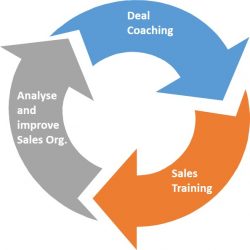One benefit of a coach is the external view on the situation. Looking from the outside, several challenges can be identified in a deal:
Setup of the team and their relationship to key persons on the client side
Usually a deal team is formed considering the organisation of the supplier – balancing sales and solution people, including commercial people etc. Only after having an initial team setup, the view is then aligned on a potential fit towards the client: who is taking up the relationship with the key decision makers of the client, who is working as the day to day connection point? All to often, the account manager wants to play all those roles (and some more) and fails to understand that for a large deal, there is a multitude of relationships and therefore also several people on both sides need to be matched. The role of a deal coach will be to figure out which of those relationships might work, and which will fail. One key principle in setting up the relations is parity – a board level decider should be matched with a senior person in the supplier organisation. When starting with the account manager and his counterpart, each level more senior at the client site has to be matched with a similar increase in seniority in the deal team. One further dimension in the “right” relationships if of course the personality of the action persons – ideally, each person on the client side should be matched with someone on the supplier side that has a compatible personality. (See MBTI Concept in a future entry)
Solution fit to the requirements of the client
When reviewing a solution for an outsourcing case, we often recognise that not the requirements of the client are at the center of the solution, but the available solution elements – what is there (and has been proposed last time) will be combined into a new solution that is supposed to fit for the clients requirements.
Instead, a good solution will start with an analysis of the requirements, their weighting in importance, and also an assessment on how (and how much) a certain requirement can be met. Once this is done, the basic solution layout can be done – identifying the building blocks (prefabricated offerings) and combining them to a solution that fits. Once the basic solution is designed, the remaining gaps can be closed by custom specific solution parts – depending on the importance of the requirements, and also on the willingness of the client to pay the price premium for the customised part of the solution. A deal coach will identify if a solution has been designed “bottom up” like this or has been crafted based on an already existing solution (like a top down approach)
Those two factors – Client Relationship and Right Solution are the two root causes of winning or loosing a deal. The third, often cited, root cause – Price – is actually a consequence of lacking customer intimacy and a solution that does not fit the requirements. Only in rare cases proposals have the right solution, but a wrong price. In such cases, some basic issues in the delivery organisation are root cause that drive the cost above what the market is willing to pay.
And last, an external deal coach is not involved in the internal politics of the supplier organisation and can therefore act with a clear focus only on the deal.

